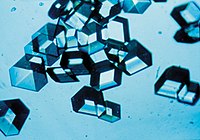
Photo from wikipedia
All laboratories dealing with microbes have to develop a strain maintenance regime. While lyophilization based on freeze-drying may be feasible for large stock centers, laboratories around the world rely on… Click to show full abstract
All laboratories dealing with microbes have to develop a strain maintenance regime. While lyophilization based on freeze-drying may be feasible for large stock centers, laboratories around the world rely on cryopreservation and freezing of stocks at −80 °C. Keeping stocks at these low temperatures requires investments of several thousand kW/h per year. We have kept yeast stocks for several decades at room temperature on agar slants in glass reagent tubes covered with vaspar and sealed with cotton plugs. They were part of the Geisenheim Yeast Breeding Center stock collection that was started in the 19th century, well before −80 °C refrigeration technology was invented. Of these stocks, 60 tubes were analyzed and around one-third of them could be regrown. The strains were typed by sequencing of rDNA PCR fragments. Based on BlastN analyses, twelve of the strains could be assigned to Saccharomyces cerevisiae, two to S. kudriavzevii, and the others to Meyerozyma and Candida. The strains were used in white wine fermentations and compared to standard wine yeasts Uvaferm/GHM (Geisenheim) and Lalvin EC1118. Even with added nitrogen, the strains exhibited diverse fermentation curves. Post-fermentation aroma analyses and the determination of residual sugar and organic acid concentrations indicated that some strains harbor interesting flavor characteristics, surpassing current standard yeast strains. Thus, old strain collections bear treasures for direct use either in wine fermentations or for incorporation in yeast breeding programs aimed at improving modern wine yeasts. Furthermore, this provides evidence that low-cost/long-term culture maintenance at zero-emission levels is feasible.
Journal Title: Fermentation
Year Published: 2020
Link to full text (if available)
Share on Social Media: Sign Up to like & get
recommendations!